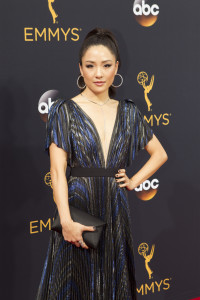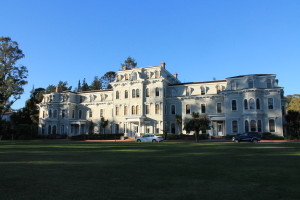
“You are exactly where you need to be,” broadcasts a Susan O’Malley piece, painted outside of the most recent exhibition at the Mills College Art Museum (MCAM). With a gradient of blue letters on a yellow background, this is a reaffirming message of optimism. However, this optimism contrasts with the thought provoking work inside the exhibit.
This exhibit celebrates and challenges traditional approaches to public art.
“Public art is often a permanent installation that relates to a specific site,” Stephanie Hanor, director of the MCAM, said in an email. “The artists in the Public Works exhibition are creating alternatives to these models… the work is often ephemeral, political, performative and uses strategies that one may not associate with art making, such as telephone recordings, newspaper ads or staging a free speech rally.”
Some pieces, such as Tania Bruguera’s Tatlin’s Whisper #6, is politically focused. This film places Cuban citizens in front of a microphone, with the premise that they have one minute to say anything they want, questioning the right to freedom of speech in Cuba. The people in the film are not actors; they are Cuban citizens. As such, their messages are straight from the heart, delivered with raw intensity.
While “Artist’s Interventions” features all female artists and art intended to be shown in a public space, rather than in an art gallery, the works displayed offer deep diversity in message, media and location. From works on paper, to contemporary installations, themes ebb and flow, from environmental sustainability, to racial imbalances.
Some of the work is traditional, such as posters and videos. There are also interactive projects, like the contemporary student-ID making installation, which creates fake student IDs. This installation was created so that everyone could try to get the student discount when they are shopping.
“I’m amazed at the variety of art,” Oakland resident Sasha Price said.
Price was also struck by the strong representation of women among both artists and attendees, and how they compliment each other.

“It’s amazing to see so many women in a single space,” Price said. “I think the art is enhanced by the fact that it’s at a women’s college. The meaning of the show changes with the audience, certainly.”
Another unique quality of the show is the setting in which the art is displayed. Since traditional public art is meant to be experienced in public spaces, rather than art galleries, the unusual context calls into question the relationship between public art and works more often seen in museums. This also begins to break down the traditional barriers between the two.
“The show is more moving than traditional shows,” Amina Khribeche, a second-year biology major, said. “The fact that these pieces are meant for the general public, rather than artists, makes this show and its emotional documentary more accessible to non-artists.”
One series, by Laurie Jo Reynolds, is an example of art meant specifically for non-artists. This series bridges the gap between fine art, the public and the marginalized community of inmates. Reynolds asked prisoners in solitary confinement at the (now closed) Tamm’s correctional center, a maximum-security prison, for photo requests. With a team of volunteers, Reynolds took the photos. Requests ranged from photoshopped images of the prisoners, to J-Lo’s butt, even a request for the prisoner’s mother in front of a mansion, with piles of money. Even people who have little inclination toward art and photography can be affected by this work because of the inclusion of these letters alongside the photographs.
The show also mixes famous art, such as that of the Guerilla Girls, with less-famous artists which impressed art history professor Dr. Moira Roth.
“Some of this art I have never seen before,” Roth said. “It’s quite exciting to learn about many new artists.”
“Artists Interventions: Public Works 1970s–Now” runs until Dec. 16 at the MCAM. The museum is open with no charge from Tuesday through Sunday from 11 a.m. to 4 p.m.; Wednesdays from 11 a.m. to 7:30 p.m. (510) 430-2164, mills.mcam.edu




